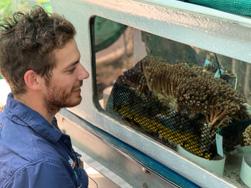Corals have released their egg bundles in the first annual ‘mass’ spawning on the Great Barrier Reef, and researchers at the Australian Institute of Marine Science witnessed the event in the world’s smartest aquarium the National Sea Simulator, near Townsville.
Hundreds of coral species are set to spawn over three months in October, November and December, with the timing of the seasonal phenomenon following the full moon of each month.
Spawning is also linked to seawater temperature and only happens at night, with researchers able to collect coral egg and sperm bundles for use in a range of projects, including reef restoration.
Marine scientists had a front-row seat to the event in the national Sea Simulator, allowing them to develop greater understanding of how the Great Barrier Reef is able to renew itself, and recover from the effects of coral bleaching, cyclones, water quality and other pressures.
AIMS coral biologist Dr Line Bay said this early summer period was an important time of year when many corals and other important reef creatures such as marine sponges, reproduced.
Dr Bay said during spawning, researchers were able to harness the critical life-cycle in nature, in a bid to discover answers of how to help reefs restore and adapt into the future.
“In the lead up to each of these spawning events, our scientists bring corals to the National Sea Simulator; where spawning occurs in this highly-advanced research aquarium, as they would in nature,” Dr Bay said.
“Teams of scientists worked through the night to conduct a range of experiments in order to address critical knowledge gaps in how corals respond, and recover from stress.
“The corals which have spawned tonight are inshore corals from Magnetic Island, with another two larger spawning events expected on the mid-shelf and outer reefs in the days after the November and December full moons.”
AIMS National Sea Simulator manager Craig Humphrey said about 18 acropora or `reef-building’ coral species from Magnetic Island had spawned in the highly-specialised aquaria.
“This research gives marine scientists critical knowledge of how reefs reproduce as well as the early life of corals including their settlement, growth and survival rates, in a controlled environment,” Mr Humphrey said.
Marine scientists travel from around Australia and the world, to conduct their research at AIMS’ National Sea Simulator during coral spawning.
Media Contact
Corporate Communications and Public Affairs - Media Officer
Emma Chadwick: 0412 181 919 or e.chadwick@aims.gov.au
This downloadable release was distributed to selected media on 17th October 2019


